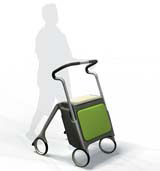Inclusive design broadens reach in DBA Challenge

The practice of inclusive design is being adopted by a widening range of design groups, says the Design Business Association, which has unveiled the shortlist for its sixth annual Inclusive Design Challenge, organised in collaboration with the Helen Hamlyn Research Centre at the Royal College of Art.
Ideas generated by six consultancies have been shortlisted for the competition – three from product design groups and three by graphic or branding consultancies. It is the first time there has been an equal split between the two disciplines – an indication, it says, of a ‘growing awareness, from designers of all disciplines and their clients, of the benefits of being associated with inclusive design’.
‘The challenge started off rather product based, as people felt that it was easier to demonstrate inclusive design ideas through products. But we keep the brief open, to get as many entries as possible, and there are now more from the communications side,’ says DBA programme director Hannah Paterson.
Each entry is conceived to solve usability difficulties faced by people with sight, mobility, cognitive and dexterity problems. On the communications side, Adecco is presenting a food packaging graphic system which allows consumers to easily identify a product’s ingredients, including those connected with food allergies and health concerns. Another food-related entry is Coley Porter Bell’s talking packaging, The Chatterpack, which guides customers with warnings or suggestions.
Wire Design is putting forward a computer software package for designers called Consider, which enables users to view the way a piece of design work would appear to people with different visual impairments. The programme is intended to be embedded into Adobe software and can recreate the viewing conditions of those with vision cataracts, dyslexia or diabetic retinopathy, a disease of the retina due to diabetes.
‘My big worry is that there are more people aware of inclusive design issues, but they don’t understand how to approach it,’ says Wire Design founding partner John Corcoran. ‘We are trying to demonstrate the principle that there is a need for this kind of product and to look at the relationship between clients and designers [on this issue].’
Matter New Product Development has designed a fire extinguisher for use in the home, with attention to difficulties encountered by visually impaired people or those with mobility or dexterity problems. Felton Communications’s entry aims to reduce job opportunity discrimination against disabled people, with a website offering information for employers and training opportunities. Wood & Wood Design is entering The Caddy – an alternative travel accessory to the ‘granny trolley’, that, it claims, will aid and enhance mobility.
The design challenge aims to raise the profile of inclusive design in new product development on both the consultancy and client side. However, none of the products from previous years have yet been put into production, according to Paterson. Last year’s winner, Pearson Matthews, is still in discussions over the possible manufacture of its Clevername plaster, she says (DW 10 February 2005).
‘There are lots of patents being sought, but clients tend to identify particular needs themselves rather than go down the route of letting people come to them with ideas,’ says Paterson.
By Scott Billings
DBA INCLUSIVE DESIGN CHALLENGE:
• Shortlisted consultancies/ Wood & Wood Design, Wire Design, Felton Communications, Matter New Product Development, Coley Porter Bell and Adecco (IBM’s design and copywriting team)
• Organised in association with the Helen Hamlyn Research Centre at the Royal College of Art, where the winner will be announced on 22 February
• There are 6.8 million disabled people of working age in the UK
-
Post a comment




